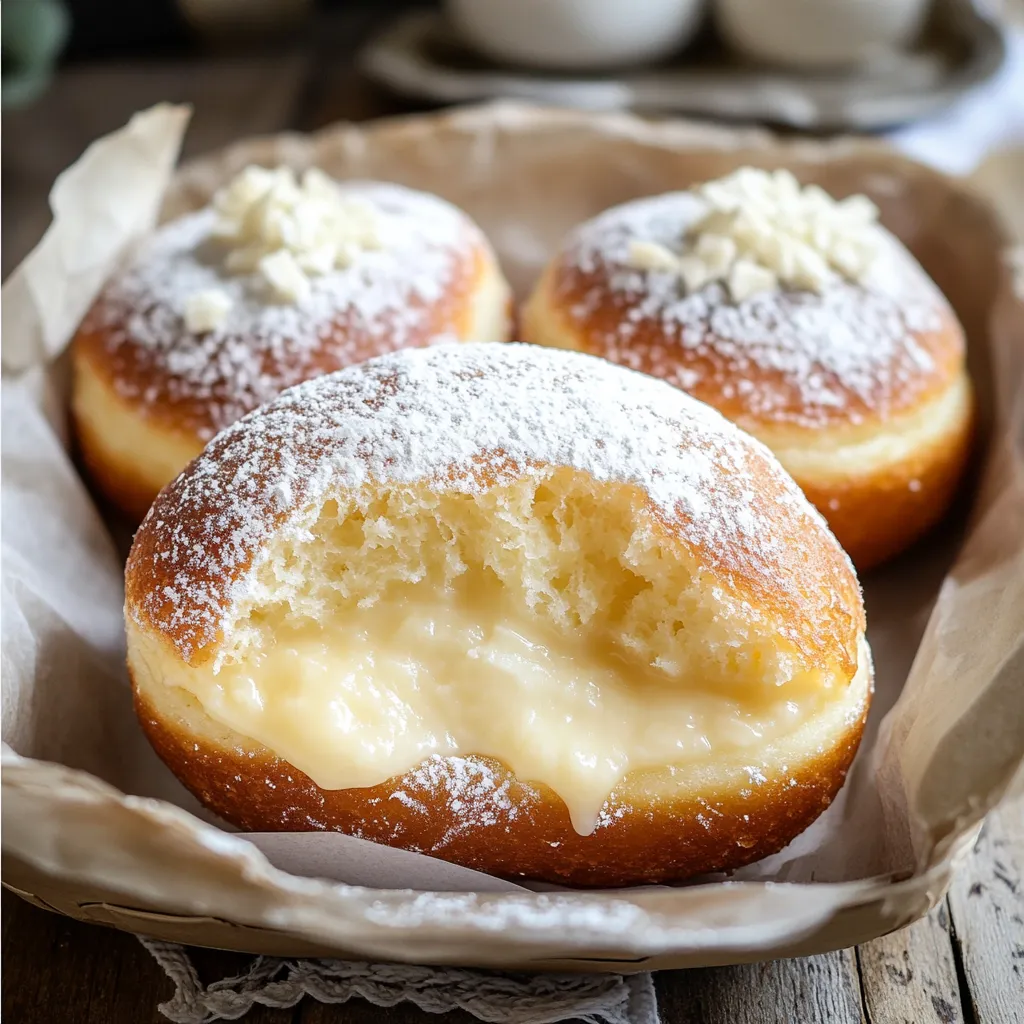 Pin it
Pin it
Bomboloni are soft, pillowy Italian doughnuts that will transport your taste buds straight to a cozy café in Florence. These delightful treats feature a delicate, airy dough rolled in sugar and generously filled with rich Italian pastry cream. The dough rises beautifully, creating that signature light texture that practically melts in your mouth while the creamy filling provides the perfect contrast. In Italy, locals often enjoy these delectable treasures for breakfast alongside a strong cappuccino, making mornings something to look forward to.
I still remember my first attempt at making these Italian treasures. The kitchen smelled absolutely heavenly as they fried, and watching my family's eyes light up when they bit into the cream-filled centers made every minute of preparation worthwhile. The contrast between the slight crispness of the sugar-coated exterior and the cloud-like interior creates a textural experience that's simply unforgettable.
Essential Ingredients
- All-purpose flour and bread flour: Using a combination creates the perfect structure while keeping the doughnuts light and airy.
- Active dry yeast: Ensures proper rising and that distinctive fluffy texture bomboloni are famous for.
- Whole milk: Adds richness and tenderness to the dough that water simply cannot provide.
- Unsalted butter: Incorporates necessary fat for flavor and prevents the doughnuts from becoming too dense.
- Granulated sugar: Sweetens the dough delicately and creates that irresistible coating on the exterior.
- Eggs: Provide structure, richness, and help create that beautiful yellow interior crumb.
- Vanilla extract: Enhances the overall flavor profile without overwhelming the delicate dough.
- Salt: Balances the sweetness and activates the yeast for proper rising.
- Egg yolks: Form the base of the silky pastry cream filling, contributing richness and color.
- Cornstarch: Thickens the pastry cream to the perfect pipeable consistency.
- Lemon zest: Adds brightness that cuts through the richness of the cream.
Crafting Perfect Dough
- Mixing Magic:
- Combine your flours, sugar, and yeast in a large mixer bowl, stirring gently to incorporate. Scatter small cubes of cool butter across the surface, then add your eggs and lukewarm milk. The milk temperature matters tremendously here – too hot will kill the yeast, too cold will slow activation.
- Kneading Technique:
- Attach your dough hook and mix on low speed for a full 10 minutes. Patience is crucial during this stage as the gluten develops slowly, creating that characteristic stretchy, slightly tacky texture that indicates perfect dough development. The dough should pull away from the sides while remaining attached to the bottom of the bowl.
- First Rise:
- Shape your dough into a smooth ball using light, gentle movements. Place it in a greased bowl, covering with plastic wrap or a damp towel. Allow it to rise in a warm, draft-free location for 2-3 hours until it triples in size. This extended rise develops complex flavors and airy texture.
 Pin it
Pin it
I absolutely adore working with yeasted doughs like bomboloni. There's something almost magical about watching them transform from a simple mixture of flour and milk into these pillowy delights. My grandmother taught me to respect the dough, never rushing the process, and her patience produced the most incredible bomboloni in our small town. The tradition of making these treats has been passed down through generations in my family, with each person adding their own special touch to the recipe.
Amazing Fillings
The classic Italian pastry cream filling for bomboloni combines rich egg yolks with milk, sugar, cornstarch, vanilla, and a hint of lemon zest. This creates a silky, flavorful custard that complements the light dough perfectly. To make this traditional filling, whisk egg yolks with sugar until pale and fluffy, incorporate cornstarch, then gradually add hot milk while whisking constantly. Return the mixture to heat, stirring continuously until thickened. The addition of limoncello or lemon zest provides a bright, citrusy note that balances the richness beautifully.
 Pin it
Pin it
Making bomboloni has become one of my favorite weekend rituals. There's something deeply satisfying about the entire process, from watching the dough rise to seeing the golden orbs puff up in the hot oil. While they require some time and patience, the results are absolutely worth the effort. These aren't ordinary doughnuts – they're little pillows of joy that bring people together around the table, creating memories along with incredible flavors. Whether you're making them for a special breakfast or as a dessert for guests, bomboloni are guaranteed to bring smiles and requests for seconds.
Frequently Asked Questions
- → Can I make bomboloni dough ahead of time?
- Yes, you can prepare the bomboloni dough the day before and let it slow-rise in the refrigerator overnight. Just bring it to room temperature before rolling and cutting.
- → What's the best oil for frying bomboloni?
- Neutral oils with high smoke points work best, such as sunflower or vegetable oil. The oil should be at 170°C/337°F for perfect frying results.
- → Why didn't my bomboloni rise properly?
- This could be due to inactive yeast, dough that's too cold, or not enough proofing time. Make sure your yeast is fresh and allow sufficient time for the dough to triple in size.
- → Can I bake bomboloni instead of frying them?
- While traditional bomboloni are fried, you can bake them at 350°F for about 12-15 minutes. They won't be quite the same texture but still delicious.
- → How long do filled bomboloni stay fresh?
- Filled bomboloni are best eaten the same day they're made. If you must store them, keep in an airtight container at room temperature for 1-2 days maximum.
- → What other fillings can I use besides pastry cream?
- Nutella, jam, lemon curd, chocolate ganache, or dulce de leche all make delicious fillings for bomboloni.
